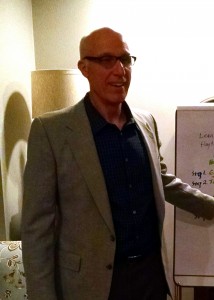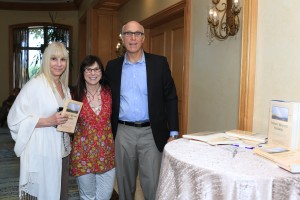
… directions, like migration routes and water sources. This one points to the creek below. It has all the distinguishing traits including irregularities in the wood, seen just above my finger. These notches were created by the deer-hide straps holding the sapling in shape, and the “nose” made by lashing a corner into the bent sapling and planting it back in the ground. Wonderful and sacred to me.
even if they don’t want it.
What appears bad manners, an ill temper or cynicism
is always a sign of things no ears have heard,
no eyes have seen.
You do not know what wars are going on down there where the spirit meets the bone.
Waking up at three in the morning and not being able to fall back asleep is rough. Going to bed at 11 pm, but not falling asleep till 1:30 am is equally wicked. Let’s look first at the biochemistry of sleeplessness, and then explore two techniques useful in putting yourself into sleep. 
By and large, it’s a chemical reaction that keeps us awake–one instigated by our thoughts and feelings. The trick then, is creating a different chemical reaction, requiring different thoughts and feelings.
Here’s what I mean. More often than not, when we can’t fall asleep, our minds are chewing on some thought. But by the nature of that thought, we begin to feel more and more anxious, nervous or scared. It’s those uncomfortable feelings that begin the biochemical process. Essentially, those scary thoughts, that then make us anxious, produce a fight or flight reaction in the body. Literally, when in a fight or flight reaction, the body pumps hormones through us that ready us for action. You know those chemicals are coursing through you when you start twisting and turning. The chemicals are trying to activate you so you can protect yourself. That’s because the scary thoughts and feelings are telling the body it needs to protect itself. Great when chased by a dog. Not great when wanting sleep.
When trying to sleep, we want chemicals or hormones released by our bodies that encourage relaxation. But if our minds are chomping on scary thoughts the body is incapable of those relaxation hormones.
This is where the techniques come into play. Both techniques below offer replacement thoughts that produce more comforting feelings, that then encourage the body to release more relaxing chemicals. The techniques are called The Golden View and The Compassionate Heart.
Let’s start with The Golden View exercise:
Step 1. Recognize that your mind is racing
Step 2. Imagine an ideal or Golden solution to the fearful situation your mind is stuck on
Step 3. As your mind pulls to return you to the fearful thinking and feeling, gently continue to fill in all the details of your Golden View of the future as your ideal solution unfolds.
Now a look at The Compassionate Heart exercise:
Step 1. Recognize that your mind is racing or uncomfortable
Step 2. Call to mind someone you know who’s struggling or in some kind of pain
Step 3. As you inhale, compassionately see that person, and as you exhale, send them love and trust
Greg was given a warm welcome by both presentation attendees and CSC Program Director, Renata Sledge, MSW, LCSW. Here are a few of the solid program reviews:
“Very much enjoyed the material and look forward to reading the book [Journey Beyond Hardship]! Thank you so much for your insight and deep caring.” Julia Germanese-Clark
“I thought it was wonderful that you were able to give such clear responses to questions.” Ruth Ann Edwards
“Triple A [exercise] seems practical and doable. This is all like a Rumi quote! I almost get it, but I need to think it through again and again.” Tess Pardini*
CSC is an international not-for-profit that provides free, high-quality support for cancer patients and their loved ones. The St. Louis CSC is a beautiful facility located off Manchester and 270, with several large, lush group therapy rooms, and larger spaces for yoga, Tai Chi, and presentations. It includes a fully functioning kitchen for special classes on food prep for cancer patients.
CSC runs weekly psychotherapy groups for cancer patients led by licensed counselors extensively trained in the CSC model. The organizations also offer similar groups for loved ones of the cancer patients. In addition, counseling groups are provided for survivors of specific kinds of cancer.
CSC was joined a few years back by Gilda’s Clubs, and all services are free, thanks to the hard work and generosity of the local and national boards’ of directors. For more information visit www.cancersupportstl.org or call (314) 238-2000.
You can order a copy of Journey Beyond Hardship by clicking the Amazon button on the “Book” page of this website.
By the way, if you’ve already read Journey Beyond Hardship, please consider writing a review on Amazon.
*All quotes offered with written permission from those quoted.
 Amazon readers have given 100% 5-Star Reviews to Greg Pacini’s new book, Journey Beyond Hardship. Here are their powerful and positive reviews:
Amazon readers have given 100% 5-Star Reviews to Greg Pacini’s new book, Journey Beyond Hardship. Here are their powerful and positive reviews:
Two Thumbs Up!
This is a positive, affirming book that helps take you through the ups and downs of life. The easy-to-read format offers clear guidance to take you along your journey. The “rest stops” are great tools to come back to when you need a tune-up. I highly recommend this book for anyone who is struggling to find their way to a peace within themselves.
—Lynne Christman
Profound and Insightful!!!
Greg Pacini has written a book that shares many profound insights with his readers. The book is written as if the reader is on a road trip. This format encourages a way of exploring the journey through the hardships of our lives. The idea of rest stops along the way suggests the reader should stop and reflect on varied ways of self-care that are offered at these junctures in the book. Life can be filled with ups and downs and Pacini’s book offers many ways to work through the hardships presented to many of us in life. I particularly enjoyed the chapter: “Further Destinations: Matters of Spirit.” This book offers compassionate and hopeful insights to all who read it. I would recommend this to all who are seeking a path that gives meaning to the many facets of suffering.
—Mary Francis Hoffman PHD, RSME, RYT
An Insightful and Practical Resource.
This book offered clarity and hope at a difficult time in my life. As I experienced multiple hardships at once my inner world was chaotic and frightening and the journey metaphor offered a practical approach and first steps and is easy to understand. I’m now rereading both this book and Journey Beyond Diagnosis as they are packed with good stuff and have many layers. Still on round two I’m comforted by curling up somewhere cozy with this book.
—Mamamia
See the reviews on Amazon or order your copy by clicking the Amazon button on the “Book” page of this website.
“Greg’s new book, Journey Beyond Hardship, is a book I personally recommend to anyone going through challenging times. ![]() ? This is part of the forward I wrote for the book: ‘Greg offers a loving and effective roadmap for getting through hardship, complete with tools for the trip. Not only that, his book gives all of us insights for a meaningful vital life…’
? This is part of the forward I wrote for the book: ‘Greg offers a loving and effective roadmap for getting through hardship, complete with tools for the trip. Not only that, his book gives all of us insights for a meaningful vital life…’
If you or someone you know could use some extra support right now, please check out this book. Sending you much love,
Anita”
Thank you very much, Anita. And here’s the good news I’ve been waiting to share.
Hay House, one of the world’s largest publishers, is now carrying Journey Beyond Hardship in their Fall Catalog! Order it by simply clicking this Amazon link: ![]() https://www.amazon.com/…/obi…/ASIN/1504329104/hayhousecom-20 or through the Hay House catalog here:
https://www.amazon.com/…/obi…/ASIN/1504329104/hayhousecom-20 or through the Hay House catalog here: ![]() http://www.hayhouse.com/catalogs/balboa-press-catalog.
http://www.hayhouse.com/catalogs/balboa-press-catalog.
Larry Dossey, MD, and Anita Moorjani, both New York Times bestsellers, endorse the book. And I just discovered three wonderful reviews of the book on Amazon.
As much as I dislike self-promotion, here I go, and let me explain. If the book sells well in the Fall Catalog, it may be included in the Holiday Catalog, which is seen by tens of millions. That means millions of people may learn about a book that can really help them, and that’s why I wrote it. So, consider ordering a copy as a holiday gift.
Please consider sharing this post on your Facebook pages, and such.
Thanks, and much peace,
Greg
- “Outstanding speaker!”
- “Very appropriate, important topic and the speaker was engaging.” Sarah J.
- “Enjoyed awesomely.” Modenia Black-Drake
- “Presenter had good rapport with the audience and created good interaction.”
- “Top notch!!” Mike Boyd
- “Liked that I was forced to go deep.” Patty Valentini
- “Feel like this is the first person who understands how I feel. Everyone should have this session.” Cindy Carter
- “Reality was presented-life as a whole.”
- “Surprising and interesting.”
- “I learned something about the biology of hope.”
- “Excellent presentation which promoted a deeper understanding of subject.” Cindy Ralston
- “Very good; Interaction.”
- “Compassion fatigue spelled out for me.” Hugh Schaffer
- “I would be interested to have you share info re: Compassion fatigue with my nurses, if I can find funding and approval.”
- “Very helpful.” Darlene Jerose
- “Necessary topic for SG leaders of incurable disease. Gained some tools for coping. Thanks.” Gail G. McCray
- “An energetic presentation by an energetic presenter.” Godfrey Taylor
- “I have a greater understanding of hope.”
- “Very enthusiastic about his field. Well communicated.”
So many come from homes where more attention was given to what was wrong with the child rather than what was right. And, sadly, many other children have faced violence, neglect and abuse. In all these cases, the child’s mind begins to feel chaotic, not knowing when another episode of shaming or violence will surface. Gradually, this inner chaos feels like the norm. So much so, that when things don’t feel chaotic, the world doesn’t feel normal: doesn’t feel right.
Enter The Snow Globe Effect: shaking things up because chaos feels more familiar than true peace or love.
Endorsed by two New York Times bestselling authors.”






